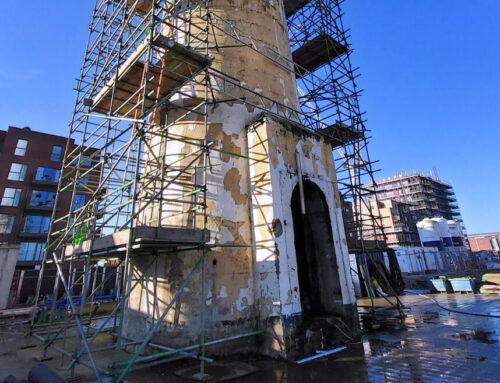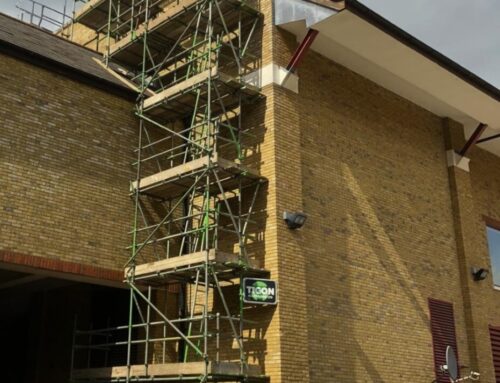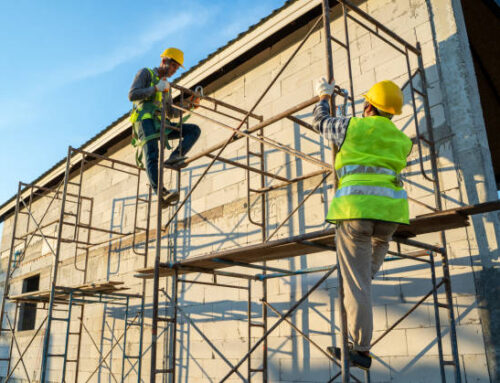As the winter months settle in, construction sites across the United Kingdom face a new set of challenges. Among the many aspects of construction, scaffolding is one that requires special attention during this season. The cold weather, frost, snow, and ice can introduce significant risks to scaffolding structures and the safety of workers.
In this blog, we will explore the essential practices for ensuring winter scaffolding safety measures are met. The winter season demands a proactive approach to safeguarding workers and maintaining construction project timelines.
Winter scaffolding safety is not just a regulatory requirement; it’s a critical aspect of construction project management. By understanding the impact of cold weather, implementing key safety measures, reinforcing scaffolding structures, and adhering to industry standards, we can create a safer and more secure environment for scaffolding operations during winter.
The Impact of Cold Weather on Scaffolding
Before we delve into the specific safety measures, it’s crucial to understand the challenges posed by cold weather to scaffolding structures. Winter conditions can have a profound impact, potentially compromising the stability and safety of scaffolds. Here are some of the key ways in which cold weather affects scaffolding:
1. Frost and Ice
Low temperatures can lead to the formation of frost and ice on scaffold components. This ice can make surfaces slippery, increasing the risk of slips and falls for workers.
2. Material Changes
Materials used in scaffolding can behave differently in cold weather. Metals may become more brittle, and wooden components may contract or warp. These changes can affect the structural integrity of the scaffold.
3. Snow Accumulation
Snow accumulation on scaffolding can add a significant load to the structure. Excess snow weight can lead to overloading and potential collapse if not addressed promptly.
4. Reduced Visibility
Winter conditions often come with reduced visibility due to fog, snowfall, or early darkness. Poor visibility can increase the risk of accidents on scaffolding, making it essential to implement adequate lighting and safety precautions.
5. Freezing Temperatures
Extreme cold can affect the functionality of scaffolding equipment, such as winches, ropes, and pulleys. Frozen mechanisms can hinder the safe operation of scaffolding.
Understanding these challenges is the first step in developing effective scaffolding safety measures. In the following sections, we’ll explore specific strategies and precautions to mitigate these risks and ensure safe scaffolding operations during the colder months.
Winter Scaffolding Safety Measures
As winter sets in and temperatures drop, implementing the right safety measures becomes paramount to protect workers and maintain scaffolding stability. Here are essential safety measures to consider:
1. Regular Inspections
Frequent inspections are crucial, especially in winter. Check scaffold components for signs of frost, ice buildup, or material changes. Inspect for any damage or weakening caused by cold weather.
2. De-Icing
Prior to starting work, ensure that all scaffolding surfaces are free from ice and frost. Use appropriate de-icing agents and tools to remove any slippery layers, preventing accidents due to slips.
3. Anti-Slip Solutions
Incorporate anti-slip materials or coatings on scaffold platforms and walkways. These solutions enhance traction and reduce the risk of workers losing their footing in icy conditions.
4. Snow Removal
Regularly remove snow accumulation from scaffolding structures. Excess snow adds weight and can lead to overloading. Use snow guards and barriers to prevent snow from falling onto lower levels.
5. Heat Sources
Consider using portable heaters or enclosures to maintain a moderate temperature on scaffolds. This helps prevent materials from becoming too brittle and ensures that workers stay warm and focused.
6. Proper Attire
Require workers to wear appropriate winter clothing, including insulated gloves, thermal layers, and slip-resistant footwear. Adequate attire minimises the risk of cold-related injuries and discomfort.
7. Adequate Lighting
In areas with reduced visibility, install proper lighting to ensure that workers can see clearly and navigate scaffolds safely. Well-lit work areas reduce the chances of accidents.
8. Training and Awareness
Provide workers with specific training on winter scaffolding safety measures. Ensure they are aware of the risks associated with cold weather and how to respond to changing conditions.
9. Weather Monitoring
Stay updated on weather forecasts and be prepared to halt work if conditions become too hazardous. Implement a clear protocol for suspending work during severe weather.
10. Reinforcement for Cold Weather
While not in the title, scaffolding reinforcement for cold weather is crucial. Strengthen scaffold structures as needed to withstand the additional challenges posed by winter. This may include additional bracing and support.
By proactively addressing these Winter Scaffolding Safety Measures, you can minimise the risks associated with winter scaffolding and create a safer working environment for your team. In the next section, we’ll explore scaffolding reinforcement techniques specifically tailored to cold weather conditions.
Scaffolding Reinforcement for Cold Weather
When it comes to winter scaffolding, reinforcement is essential to ensure the stability and safety of the structure. Cold weather brings unique challenges that require specific strategies to address. Here are some scaffolding reinforcement techniques tailored for cold weather conditions:
1. Additional Bracing
Cold weather can make materials more brittle, increasing the risk of structural failure. To counter this, consider adding extra diagonal and horizontal braces to enhance the scaffold’s stability.
2. Use of Wind Bracing
Strong winter winds can exert additional force on scaffolding, potentially leading to instability. Incorporate wind bracing to counteract these forces and keep the scaffold secure.
3. Load Capacity Assessment
Assess the scaffold’s load capacity to ensure it can withstand the added weight of snow, ice, and workers in winter conditions. Make necessary adjustments to accommodate the increased load.
4. Inspection Hooks
Install inspection hooks on scaffold components. These hooks allow for easy attachment points for safety lines, ensuring workers are securely tethered and preventing falls.
5. Reinforced Platforms
Strengthen scaffold platforms to handle the weight of workers, tools, and equipment in cold weather. Ensure they are reinforced and can support the load without compromising safety.
6. Material Selection
Choose scaffold materials that are suitable for cold weather. Some materials may become brittle in freezing temperatures, so opt for those that can withstand the cold without compromising integrity.
7. Regular Maintenance
Maintain scaffolding regularly throughout the winter season. Check for signs of wear and tear, and address any issues promptly to prevent structural problems.
8. Snow and Ice Management
Implement a snow and ice management plan. Regularly remove snow and ice buildup from scaffold components to prevent overloading and ensure safe working conditions.
9. Worker Training
Train workers on the specific challenges posed by winter conditions. Ensure they understand the importance of scaffold reinforcement and cold weather safety measures.
10. Professional Assessment
Consider having a professional engineer or scaffolding expert assess the scaffold’s design and reinforcement needs for winter conditions. Their expertise can help ensure safety and compliance.
By incorporating these scaffolding reinforcement techniques, you can enhance the stability and safety of your scaffolding during cold weather. These proactive measures help protect workers and prevent accidents, ensuring that construction projects proceed smoothly even in winter’s chill.
Worker Training and Awareness
Ensuring the safety of workers during cold-weather scaffolding projects extends beyond providing the right equipment and following safety protocols. It involves equipping the workforce with the knowledge and awareness needed to navigate the unique challenges presented by winter conditions.
By prioritising worker training and fostering awareness, you empower your team to handle the unique challenges of winter scaffolding projects safely and effectively. When every member of the workforce is well-prepared and vigilant, the risk of accidents and injuries decreases significantly.
Winter scaffolding safety measures are not only a legal requirement but also a fundamental responsibility to protect the well-being of workers and ensure the successful completion of construction projects during cold weather. By adhering to stringent safety standards, implementing appropriate equipment and procedures, and prioritising worker training and awareness, construction companies can mitigate the unique risks posed by low temperatures and adverse weather conditions.
The key takeaways for ensuring winter scaffolding safety include:
- Compliance with Regulations: Familiarise yourself with the legal obligations and regulations governing cold-weather construction. Ensure that your scaffolding operations align with these requirements to avoid potential liabilities.
- Scaffold Reinforcement: Invest in cold-weather scaffolding solutions, such as reinforcing materials and anti-slip surfaces, to enhance stability and safety in winter conditions.
- Weather Monitoring: Stay informed about weather forecasts and potential temperature drops. Implement proactive measures to protect workers and equipment from extreme cold.
- Worker Training: Provide specialised training for your workforce, emphasising the recognition of cold stress symptoms, the proper use of cold-weather gear, and emergency response procedures.
- Regular Inspections: Conduct frequent scaffold inspections to identify and address any issues that may compromise safety in winter conditions.
- Communication and Awareness: Foster a culture of open communication and safety awareness among your team members. Encourage reporting of unsafe conditions and incidents without fear of reprisal.
By integrating these safety measures into your cold-weather scaffolding practices, you not only reduce the risk of accidents and injuries but also ensure the continued progress of construction projects even in challenging winter environments. Prioritising safety throughout the year, regardless of the weather conditions, underscores your commitment to the well-being of your workers and the successful execution of your projects.
As winter approaches, remember that a proactive approach to scaffolding safety is the best defence against the cold’s potential hazards. By safeguarding your workers and your construction projects, you can continue to build with confidence, even when the temperature drops.














